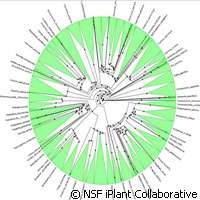When plants spin off new species

(PhysOrg.com) -- Contrary to what most people may think, the speciation rates of plants are not linked to the first development of a novel physical trait or mechanism. New international research shows that plants fiddle around with their performance and configuration before setting out to create better versions of themselves. The findings are presented in the journal American Journal of Botany.
Scientists from the Heidelberg Institute for Theoretical Studies (HITS) in Germany, along with colleagues from Brown University and Yale University in the United States, succeeded in reconstructing the phylogeny - the history of organismal lineages as they change through time - for plants. By reconstructing the tree of life, the German and American researchers shed new light on the evolutionary process.
What perplexed researchers for some time was the timing when a clade launched into the creation of a new species. Clades are groups of plants that have the same ancestor. Researchers believed that rapid speciation took place when a clade initially developed a new physical trait or mechanism, and then launched into creating its own genetic branch.
This latest study shows that only when the flowering plants reached a point of development at which speciation success and rate would be maximised did the major lineages of these plants start to spin off new species quickly, according to the team.
"Evolution is not what we previously thought," explains Dr. Stephen Smith, a post-doctoral researcher from Brown University, who is also affiliated with HITS and the lead author of the study. "It's not as if you get a flower, and speciation (rapidly) occurs. There is a lag. Something else is happening. There is a phase of product development, so to speak."
So what was the best approach to get to the bottom of this issue? The team found that computational methods played a critical role. 'This is a nice example of how computer science and cyberinfrastructure initiatives can help to extend the limits of biological explorations,' HITS' Alexandros Stamatakis, one of the co-authors of the study, points out.
The team computed the biggest evolutionary tree, taking care to include 55 473 species of flowering plants (i.e. angiosperms). The genealogical line represents around 90?% of all planets available on our planet.
The researchers evaluated the genetic profiles of six major angiosperm clades, namely grasses (Poaceae), orchids (Orchidaceae), sunflowers (Asteraceae), beans (Fabaceae), eudicots (Eudicotyledoneae) and monocots (Monocottyledoneae). They said Mesangiospermae, a clade that materialised over 125 million years ago, was the branches' common ancestor. But they discovered that speciation only came after some time, not around the ancestral root. It should be noted that it was not possible for the team to pin this down to a specific time.
"During the early evolution of these groups," Dr. Smith says, "there is the development of features that we often recognise to identify these groups visually, but they don't begin to speciate rapidly until after the development of the features."
Writing in the paper, the authors say: "These findings are consistent with the view that radiations tend to be lit by a long "fuse," and also with the idea that an initial innovation enables subsequent experimentation and, eventually, the evolution of a combination of characteristics that drives a major radiation."
Future research will seek to determine the triggers for the speciation boon, and to provide insight into how plants grow faster and outrun their 'peers'.
More information: Smith, S.A., et al. (2011) Understanding angiosperm diversification using small and large phylogenetic trees. American Journal of Botany. DOI: 10.3732/ajb.1000481
Provided by CORDIS



















